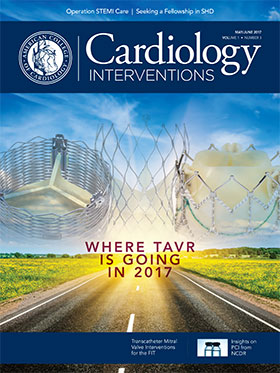Feature Story: Heart Failure: Highlights from ACC.17
A few abstracts at ACC.17 in the heart failure arena caught our eyes along with the Late-Breaking Clinical Trial called LEVO-CTS. Here’s a quick review.
The relentless rise in the prevalence of heart failure with preserved ejection fraction (HFpEF) continues to spur efforts to understand its pathophysiology. Two studies presented at ACC.17 are providing some more insights. Of the approximately 5.1 million people in the U.S. who have HF, about half are women and they have a 50 percent mortality rate at five years. An ancillary study from the Women’s Ischemia Syndrome Evaluation (WISE) in women with signs and symptoms of ischemia but without obstructive coronary artery disease (CAD) had shown an independent association between traditional cardiovascular risk factors and the development of HFpEF.
 |
In their newest ancillary study with the WISE population, Parham Zarrini, MD, and colleagues identified risk factors associated with HFpEF, including a pro-inflammatory state as measured by interleukin-6 (IL-6).
Their study included 493 women from the WISE population who had normal epicardial coronary arteries or non-obstructive CAD and no history of HF. Over the median six-year follow-up, 18 women were hospitalized for HF, and their mean age was 57 years (vs. 55 years in those who were not) and 83 percent were white. More of the women who were hospitalized, compared with those who were not, had non-obstructive CAD (61 vs. 40 percent), diabetes (33 vs. 14 percent), and chronic kidney disease (11 vs. 2 percent). Blood pressure levels in the two groups, respectively, were 145/82 mm Hg and 135/77 mm Hg.
Analyses were conducted of the association between risk factors and the time to HF hospitalization. Among the significant risk factors identified in the model adjusted for age, diabetes, smoking and statin use were diabetes (hazard ratio [HR], 3.97), coronary flow reserve (CFR) (HR, 3.39 per one unit decrease), IL-6 (HR, 2.59) and progesterone (HR, 1.98 per 0.1 ng/dL decrease). Also identified as significant risk factors were the Duke Activity Score Index (HR, 1.61 per 10 decrease), pregnancy (HR, 1.25 per pregnancy), cigarettes (HR, 1.39 per 10 cigarettes), age at the onset of hypertension (HR, 1.06 per year decrease) and pulse at rest (HR, 1.05).
Their work suggests that a chronic pro-inflammatory state leads to endothelial and non-endothelial microvascular dysfunction, state Zarrini and colleagues, which has been shown by Paulus and Tschope to be associated with HFpEF. Regarding lower progesterone levels as an independent risk factor, they note that progesterone’s anti-adrenaline and vasodilatory effects may reduce chronic ischemia and thereby the risk of developing HFpEF.
Multiparity, progesterone levels, Duke Activity Score Index, IL-6 and CFR may be prognostic tools for identifying patients with a high risk of developing HF they suggest. The hypothesis that microvascular disease may be a mechanistic pathway for HFpEF is supported by the association between CFR and HF hospitalization in this study, and warrants further study, along with the mechanistic studies of the association of multiparity and progesterone levels with HFpEF.
 |
Allen J. Weiss, DO, and colleagues reported that T1-mapping during cardiac magnetic resonance (CMR) imaging detects interstitial myocardial fibrosis (IMF) and that patients with HFpEF had more IMF than healthy controls. The investigators of this single-center study state that the increase in IMF correlates with and likely contributes to impaired diastolic function and HF severity in HFpEF. Work by other investigators had previously shown that increased IMF was associated with worse left ventricular (LV) dysfunction in patients with hypertension.
In this study at Mount Sinai Hospital in New York City, 92 consecutive patients with clinically diagnosed HFpEF undergoing CMR were included and their clinical histories compared with 46 healthy controls. The study patients were 60 years old and 61 percent were women. Independent cardiologists reviewed the hospitalization parameters and performed transthoracic echocardiography.
The myocardial post-contrast T1 time in the myocardium was shorter in the patients with HFpEF (398.4 msec vs. 424.6 msec; p < 0.001). There was no difference between the groups for the post-contrast T1 time in the blood and skeletal muscle. The LVEF was 60 percent in patients with HFpEF and 63 percent in healthy controls, and there was no correlation between LVEF and T1 time. A significant correlation was found between T1 time and feature tracking longitudinal and circumferential strains. Regarding diastolic function, they found significant correlations between T1 times and E’, E/e’ ratio, and left atrial size. Finally, they found an inverse correlation between IMF and the severity of HF. T1 mapping appears to be a promising tool for evaluating patients with HFpEF.
Treatment Patterns for HF With Reduced Ejection Fraction
In the arena of HF with reduced ejection fraction (HFrEF), an interim analysis from the CHAMP-HF study has provided some insights on outpatient treatment patterns. The prospective cohort study is working to characterize current management of chronic HFrEF using a national registry of outpatient practices.
 |
Reported by Gregg C. Fonarow, MD, FACC, et al., this interim analysis includes patients enrolled between December 2015 and July 2016. Two new medications for HFrEF, ivabradine and sacubitril/valsartan, were recommended in the new 2016 focused guideline update on HF from the ACC/American Heart Association/Heart Failure Society of America.
The median age of the 1,278 patients in this analysis was 68 years and 28 percent are women and 74 percent white. The median LVEF was 30 percent and 52 percent had NYHA class II and 30 percent had class III heart failure; 38 percent had been hospitalized in the previous year. Most of the patients (90 percent) were treated at non-teaching, non-university hospitals and 60 percent had access to cardiac rehabilitation.
In the overall population, only 1.1 percent was taking ivabradine, with slightly more women than men taking ivabradine (2.3 vs. 0.7 percent). Sacubitril/valsartan use was only 13 percent in the overall population, with little difference by age above or below 65 years or sex; by NYHA class, use was 12.8 percent of class II patients, 17.8 percent of class III and 13.9 percent of class IV.
An angiotensin-converting enzyme inhibitor (ACEI) or angiotensin receptor blocker (ARB) was used in 57.4 percent, while the use of an ACEI, ARB, sacubitril/valsartan was 70.3 percent. The rates for beta-blocker use and evidence-based beta-blocker were 82.6 percent and 68.2 percent, and for aldosterone antagonist and hydralazine nitrates were 31.5 percent and 4.6 percent. Loop diuretics were used in 61.7 percent.
The authors state this interim analysis reveals the low use of the newest medical therapies for HFrEF and the low use of guideline-directed medical therapies including evidence-based beta-blockers and aldosterone antagonists.
LEVO-CTS: Levosimendan Does Not Meet Primary Endpoint
Clinical benefit was gained with the calcium-sensitizing inotrope levosimendan although the co-primary endpoints were not significantly improved in the LEVO-CTS trial evaluating the effect of the drug to prevent low cardiac output syndrome (LCOS) and its associated adverse outcomes in patients with a low LVEF undergoing cardiac surgery, according to results presented by John H. Alexander, MD, FACC.
LEVO-CTS, the first large trial to investigate levosimendan for this purpose, randomized 882 patients (median age 65 years, 19 percent women) at 70 sites in North America with a LVEF <35 percent (median 26 percent) to an intravenous infusion of levosimendan that continued for 24 hours. Most patients (66 percent) underwent CABG.
Both co-primary composite endpoints occurred at a similar rate in both the levosimendan and placebo groups and were adjusted for age, sex, type of surgery and LVEF. The first co-primary endpoint of death or dialysis through day 30, myocardial infarction (MI) or the use of a mechanical assist device through day five occurred in 24.5 percent of each group (odds ratio [OR], 1.01; p = 0.9775). The second co-primary endpoint of death through day 30 or mechanical assist device through day five occurred in 13.1 percent of the levosimendan group and 11.4 percent of the placebo group (OR, 1.18; p = 0.4501).
Of the components of the primary endpoints, MI was the most frequent at 15.7 percent and 15.0 percent with levosimendan and placebo, respectively, followed by a mechanical assist device by day five in 11.0 percent and 9.0 percent, respectively. The rates of death were 3.5 percent and 4.5 percent with levosimendan and placebo, respectively, and the rates of dialysis were 2.1 percent and 3.8 percent. The cardiac index was significantly higher with levosimendan than placebo; it was a mean 2.86 in 359 patients taking levosimendan and a mean 2.68 in 340 patients taking placebo (p < 0.0001).
LCOS, a secondary endpoint occurred in 18.2 percent of the levosimendan group and 25.7 percent of the placebo group (OR, 0.62; p = 0.007). Fewer patients taking levosimendan required an additional inotropic drug compared with placebo (54.9 percent vs 62.7 percent; OR, 0.71; p = 0.017). Mortality at 90 days was 4.7 percent with levosimendan and 7.1 percent with placebo (hazard ratio, 0.64; p = 0.123). The 30-day safety outcomes were similar in both groups.
“The drug had its intended biologic effect in increasing cardiac output and reducing low cardiac output syndrome, but that did not translate into a reduction in our endpoints,” Alexander said. “In countries where levosimendan is available, if you want a drug that increases cardiac output and has good safety data, levosimendan is a reasonable option, because other available inotropes have less well known or adverse safety data.”
 |
“Since the original study called LIDO examining the hemodynamic effects of levosimendan was published in 2002, there have been hundreds of small trials published suggesting a beneficial effect of the drug compared with alternative inotropic agents,” says Mariell Jessup, MD, FACC. Moreover, the drug is available in many countries in Europe to clinicians managing acute and/or perioperative heart failure. “Nevertheless, LEVO-CTS failed to demonstrate the superiority of the drug when used prophylactically in patients with LVEF <35 percent undergoing cardiac surgery compared with standard treatment of these high-risk surgical patients. It will be hard to envision levosimendan becoming available in the U.S.,” she says.
 |
|
| Click the cover image above to read the latest issue of Cardiology: Interventions in e-pub format or click here to read it on the web! | |
Keywords: Cardiology Interventions, ACC Annual Scientific Session, Cardiovascular Diseases, Coronary Artery Disease, Heart Failure, Prevalence, Risk Factors, Stroke Volume
< Back to Listings
